[This page is still in the works, so feel free to comment below as it’s taking shape.]
Grooveboxes are portable, versatile, and just fun. You can spend anywhere from $85 to $1,400 on one, but spending more does not always get you more.
In this article we’re going to look at some of the leading higher- end grooveboxes – so in the $600-1,400 range. To see grooveboxes at a lower price bracket, see our Guide to the Novation Circuit.
The Groove-boxing Match
To our minds, there are two strong contenders: Synthstrom’s Deluge and Akai’s MPC One.
The Deluge and MPC One are very different beasts, diametrically opposed in some ways. But if you can identify your tendencies toward or the other, that might help you narrow down toward your choices.
There is around a $300 price difference between them, but spending up isn’t always better (depending on what you want).
As you’re searching to fill your heart-shaped groovebox, you might find it useful to compare the Deluge and MPC.
What is a Groovebox?
People have different notions of what a groovebox is, but here are some relatively safe criteria.
A groovebox is:
- Independent: it does not need a DAW (Digital Audio Workstation) to work.
- Portable: you can slide it completely beneath the seat in front of you on a plane. You can even fit it on that tiny excuse for a table they give you. You can carry a groovebox easily in one hand, even if after chest-n-biceps day at the gym.
- Able to pump out rhythm (percussion) and melody (synths). Otherwise, it’s a drum machine or synth, but not a groovebox.
- Able to send and receive MIDI.
- Happy to be plugged into a computer or sound system. You should be able to perform without embarrassment in front of an audience with a groovebox.
Any groovebox should meet those criteria. But we’re now looking at non-budget grooveboxes (most around $700-$1,200). Here we also expect:
- Advanced sampling options
- SD storage
- Some kind of screen
- Not immediately intuitive: takes some serious time investment
So in this article, that’s what we mean by a groovebox. That’s why we don’t consider synths and drum machines grooveboxes.
Synthstrom Deluge
Synthstrom’s Deluge can do most anything you’d want a groovebox to do.
What you get with the Deluge is an immensely versatile, very powerful machine. Synthstrom put an incredible amount of thought into the Deluge and – in terms of design – really thought outside the groove box. It looks unlike anything else out there.
Spacially, the Deluge is an extremely well-planned groovebox. So, with relatively few knobs and a rudimentary screen, you can do most anything you’d like with the Deluge with minimal menu-diving.
The anticipated negative aspect of Deluge’s unique systems is that you will have fewer crossover skills from other gear: expect to hunker down for a while to get all you can out of this magnificent box.
Pros
- 128 pads let you see what’s happening in the sequence
- Button combinations allow quick tweaking with minimal menu-diving (once you learn it!)
- Multiple intuitive views
- Great live looping and sampling
- Very dedicated community
- Super compact
- Runs off USB
Cons
- Buttons are not velocity sensitive, no aftertouch
- Very limited, non-touch screen
- Limited external MIDI control (though may be corrected with future firmware)
- Paying shipping/import taxes
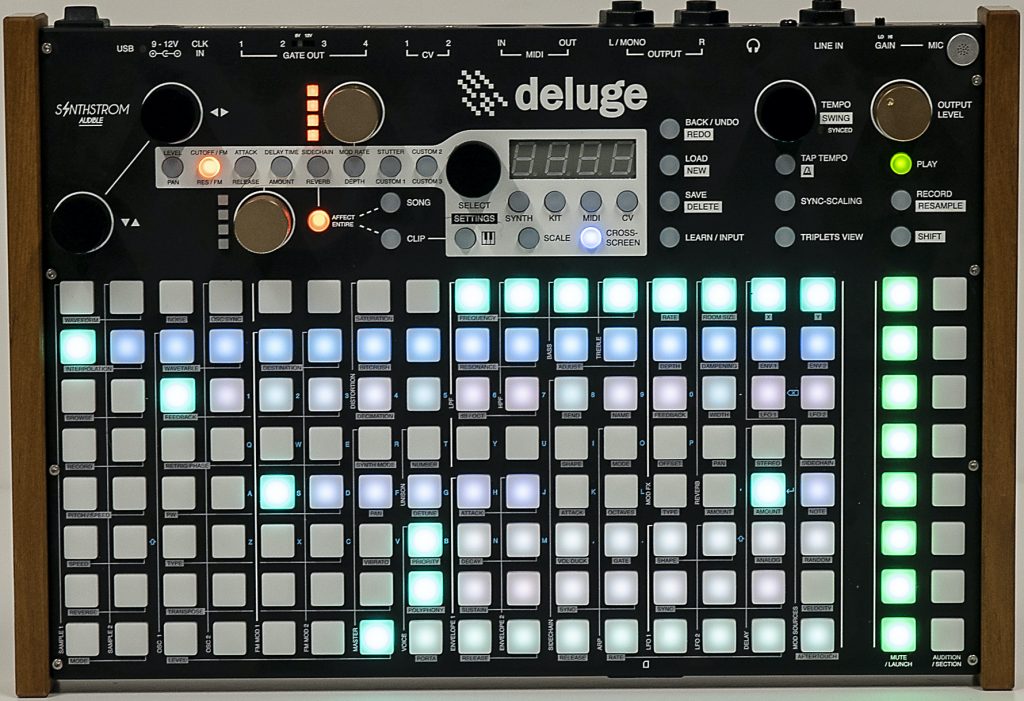
To get a first glimpse of the Deluge, let’s watch it at work:
So far, we see much that looks familiar:
- Grid-based sequencer for synth and drums
- Live entry and use of the sequencer
- 2 synths (running monophonic here)
- Automation recording of effects
And then we part ways with groove boxes like the Novation Circuit the Deluge’s longer memory (which allows longer loops and sampling) and options like sample splicing.
The Deluge can do a lot more than we see in that overview video. Let’s take a look under the hood first to see what’s there. Then we’ll look a bit closer at what it can and can’t do.
Deluge Specs (Official)
SYNTHESIZER
- Full-featured internal synthesizer engine (subtractive and FM)
- Polyphony limited only by CPU. Up to 64 synth voices may play simultaneously
- Live adjustment of synth and effect parameters with two endless-turn encoders with LED level-meters
- Easy buttons to select the functions these control
- Parameter automation recording
- Arpeggiator
- Dedicated volume and tempo knobs
- LFOs and envelopes on each synth / sample. Highly customizable modulation matrix
- Synthesizer engine features LPF / HPF, FM, portamento, oscillator sync, ring modulation, unison detune, and more
- Four basic digital waveforms, two analog-modeled waveforms, or select any WAV file from SD card
- 12dB/oct and 24dB/oct filters, with optional filter drive mode
- FX including delay, reverb, chorus, flanger, phaser, bitcrusher, sidechain effect, live stutter, and more
- Keyboard mode, where the pads become a live instrument on a 2D grid
- Preset or custom scales, or chromatic mode
- Live processing of the audio input including polyphonic pitch shifting (according to sequenced notes), filters, and all FX
SEQUENCER
- Piano-roll-style sequencing on 128 full RGB pads (16×8) with scrolling and zooming
- Launch, mute and interact with tracks live
- Arranger view, to sequence your instrument parts into a longer composition, and work with audio clips similarly to a DAW
- Sequencing limited only by device RAM (over 2 million notes)
- Resolution can be set as high as 6144th-notes
- Simultaneously output separate sequences to all 16 MIDI channels, 2 CV / gate channels and 2 additional gate outputs, in addition to internal synthesizers / samples (limited only by CPU)
- CC control and sequencing on all 16 MIDI channels
- Probability and iteration based step / note conditions
- Undo / redo note and parameter automation editing and recording. Number of undo steps limited only by RAM
- Advanced syncing capabilities. Non-standard time signatures supported, polymetric
- Adjustable swing
- Horizontal pattern shift and note nudge, and note repeat
- MIDI program change and bank select messages may be output
SAMPLER
- Streams all samples directly from SD card, without limitations based on RAM size
- Up 90 unaffected sample voices may play simultaneously
- Multisampling. Fast folder import with automatic pitch detection
- Time-stretching and pitch-shifting
- High quality sample interpolation and rate conversion via 16-point windowed sinc
- Waveform view on main pads, with scrolling, zooming, and loop point editing
- Same filters, modulation matrix and FX as synth engine
- Resampling
- Slicer feature for cutting a sample into evenly sized slices
Here’s a good overview of the sampler:
And to see it at work with some everyday household items, check out Whales Have Teeth’s vid:
AUDIO CLIPS AND LOOPING
- Live looping of audio and instrument / MIDI clips, including easy overdubbing / layering, and automatic tempo setting
- Audio clip live looping includes option to record additional audio “margins” either side of loop (from before you even pressed record), to allow a brief crossfade to eliminate click at loop point
CONNECTIVITY
- Two ¼” line outputs, and 3.5mm headphone output
- 3.5mm mic input, ¼” line input, and built-in microphone
- 2x CV outputs. 0 – 10V, individually configurable to between 0.01 and 2.00 volts per octave, or to hertz-per-volt
- 4x gate / trigger outputs individually configurable to v-trig or s-trig, with shared voltage switchable between 5V and 12V
- Trigger clock output, configurable up to 192 PPQN
- Trigger clock input, also with adjustable PPQN
- MIDI input and output via hardware connectors or USB. Syncing via MIDI beat clock as leader or follower. Optimized for very low jitter
- Powered via USB B (cable included) or 9 – 12V centre-negative (pedal-style) power supply (500mA) (not included)
- Can host USB MIDI devices via B-to-B cable – up to 4 if using a USB hub. Only powers these devices when powered by 9 – 12V supply
- User-upgradeable firmware – development is ongoing at Synthstrom Audible
- Internal speaker
- Rechargeable Li-ion battery (6+ hours of operation)
- 1 x SD slot (1x 32GB V10-speed SD card supplied)
DIMENSIONS
- Dimensions: 305mm x 208mm x 46mm (12 x 8.2 x 1.8 inches)
- Weight: 1.5kg
Deluge Tutorials
These are some of the best tutorials we’ve found.
Recommended Reviews, Demos, and Tutorials for Deluge
There are many outstanding tutorials about the Deluge, which are evidence of 1) its incredible versatility, 2) depth, and (related to these first two qualities) 3) complexity.
Official (Synthstrom Audio)
- Deluge by Synthstrom Audible (Walkthrough Part 1) (2016)
- Deluge by Synthstrom Audible (Walkthrough Part 2) (2016)
- Deluge by Synthstrom Audible (Walkthrough Part 3) (2016)
- Deluge – Time Stretching and Pitch Shifting (Tutorial) (2016)
- Deluge (improv noise, feedback and texture) (2016)
- Deluge – Parameter Automation (Demo and Tutorial) (2016)
- Deluge – Basic Workflow Tutorial with Peach Milk (2017)
- A Deluge Tip – changing song parts via ‘subslots’ (2018)
- Deluge 2.1 Firmware Feature Tease: Waveform View (2018)
- Deluge 2.1 Firmware Feature Tease: Multisampling (2018)
- Deluge 3.0 Firmware Feature Tease: QWERTY Keyboard (2019)
- Deluge 3.0 Firmware Feature Tease: Live Looping 1 of 3 (2019)
- Deluge 3.0 Firmware Feature Tease: Live Looping 2 of 3 (2019)
- Deluge 3.0 Firmware Feature Tease: Live Looping 3 of 3 (2019)
- A Deluge Tip – Fine resolutions and low BPMs (2020)
- A Deluge Tip – Sidechain experiments. (2020)
Ron Cavagnaro
Ron has a playlist of 88 Deluge tutorials (and counting). These are neatly divided into topics so you can search to find what you want.
Loopop
- “Synthstrom Deluge Review and 10 reasons why it’s special” (2017)
- “Synthstrom Deluge Review of Firmware 1.2 Top Features that unlock completely new functionality” (2017)
- “Sound design and some crazy powerful features of the Synthstrom Deluge” (2017)
- “DELUGE 3: Full tutorial and workflow walkthrough” (2019) Great overview from top to bottom with some killer tips along the way.
Mr. Wiggly
- SYNTHESISER BASICS ON THE SYNTHSTROM DELUGE (2018) Highly recommended. Great overview of Deluge’s synth engine, but also a good introduction to how subtractive synthesis works. Less time with FM, synthesis; for that you’ll want to watch…
- SYNTHSTROM DELUGE – FAT SYNTH TRICKS (2018) After these two, you might want to try LoopOp’s more advanced video.
- SYNTHSTROM DELUGE – SAMPLING BASICS (2018)
- SYNTHSTROM DELUGE – MULTI-SAMPLING MADE EASY! (2019)
BoBeats: “first time with the Deluge” (2019)
Red Means Recording
- “Introducing the Synthstrom Deluge” (2018)
- “Beats From Scratch – Synthstrom Deluge (Deep House)” (2020)
Some good specific tutorials:
- “SYNTHESISER BASICS ON THE SYNTHSTROM DELUGE” (2018)
- “Isomorphic Chords: exploring the Deluge’s keyboard” (2018)
Sampling Tutorials
- “Tutorial – Synthstrom Deluge – Sampling Part 1 – Intro and Recording”, Part 2, Part 3, Part 4 (2018)
- “Day 2: Deluge sampling workflow with objects I found in the kitchen” (2020)
- “SYNTHSTROM DELUGE – SAMPLING BASICS” (2018)
Some good demos:
- Synthstrom Online Festival #1 (Full 3-hour Stream) (2020)
- Synthstrom Online Festival #2 (2020)
- Grains (NZ) jamming on the upcoming 3.2 Deluge firmware (2020)
- ‘Halafax’ by Earthika (2020)
- ‘Insertion Loss’ by Tactile AF (2020)
- Deluge Stranger Things jam (2016)
Deluge Manual PDF and Firmware Updates
- Deluge firmware V3.1.4
- Deluge Official Guidebook – for firmware V3.1
- Deluge factory SD card contents for firmware V2.1 / V3.x
- Producer manual by Synthdawg and Synthstrom
Firmware Update Videos:
Deluge battery install instructions
Akai Professional MPC One
On the other end of the groovebox spectrum is Akai’s Professional MPC One. At a glance you can tell how far away it is from the Deluge and most other grooveboxes, including the Elektron group.

What perhaps stands out most about MPC One is that nice, bright, touch sensitive screen?
Now, some might say that the presence of a screen inhibits this from being considered a groove box. But we’re including it here because it is at the opposite end of the spectrum from the Deluge. So you can decide how much screen you want, and pick accordingly.
Even for non-purist, the MPC One’s interface looks and acts a lot more like a DAW than a traditional groovebox.
And, if you’re not looking for the connectors on the Akai’s rear, you might ask yourself: What really are the advantages of the MPC One over my iPad with Garageband?
But let’s see Akai’s MPC Professional One in action. Here’s an overview of what you can do with an MPC One.
And here LoopOp takes you under the hood to show you how to become one with the One.
MPC One Specs (Official)
Pads
- (16) velocity- and pressure-sensitive pads, RGB-backlit
- (8) banks accessible via Pad Bank buttons
Knobs
- (4) 360° touch-sensitive Q-Link Knobs
- (4) Q-Link Knob columns accessible via Q-Link button
- (1) 360° encoder for display navigation and selection via push
Buttons
- (31) dedicated function buttons; red-, amber-, or green-backlit
Display
- 7.0” / 177 mm (diagonal)
- 5.9” x 3.7” / 151 x 94 mm (width x height)
- Full-color LED-backlit display with touch interface
CPU
- Processor: Quad-core ARM® processor
RAM: 2 GB
- Storage: 2 GB user storage, 2 GB pre-installed content
Connections
- (2) 1/4” (6.35 mm) TRS inputs (1 stereo pair)
- (2) 1/4” (6.35 mm) TRS outputs (1 stereo pair)
- (1) 1/8” (3.5 mm) stereo headphone output
- (1) 5-pin MIDI inputs
- (1) 5-pin MIDI outputs
- (4) 4 TRS CV/Gate Jacks, 8 Outputs Total
- (1) USB Type-A port
- (1) USB Type-B port
- (1) SD Card slot
- (1) Power Adapter input
Power
- Via power adapter: 19 V, 3.42 A, center-positive, included
Dimensions (width x depth x height)
- 10.7” x 10.7” x 2.1”
- 272 x 272 x 53 mm
Weight
- 4.7 lbs
- 2.1 kg
Quick Comparison: Synthstrom Deluge and Akai MPC One
You can see how, in many ways, the Deluge and One are opposites. Seeing their differences side-by-side may help you decide if you want to go for one of these extremes, or if you’d prefer something in the middle.
Deluge
Many pads, limited knobs, no real screen
Workflow: fast, once you learn the shortcuts
Musical result: will need tweaking in a DAW; retains “analogue” artifacts
Experience: Feels more analogue
MPC One
Large touch screen, more limited pads
Workflow: remains medium, tied down by some menu-diving
Musical result: Seamless translation to DAW via MPC DAW
Experience: More digital, screen-based
Roland MC-707
Roland’s MC-707, with dedicated, per-track knobs and faders, is one of the more intuitive grooveboxes. Though it has some tricks up its sleeve, it is a more “what you see is what you get” groovebox.
So look for a quicker learning process, which lets you start making music faster.
While in terms of functionality it’s placed somewhere between the Deluge and MPC One, it’s priced much closer to the Deluge.
The limitations are perhaps disappointing for some – no song mode or sample splicing, for example. But the Roland is a fast-working powerhouse that retains some great aspects of the two grooveboxes above.
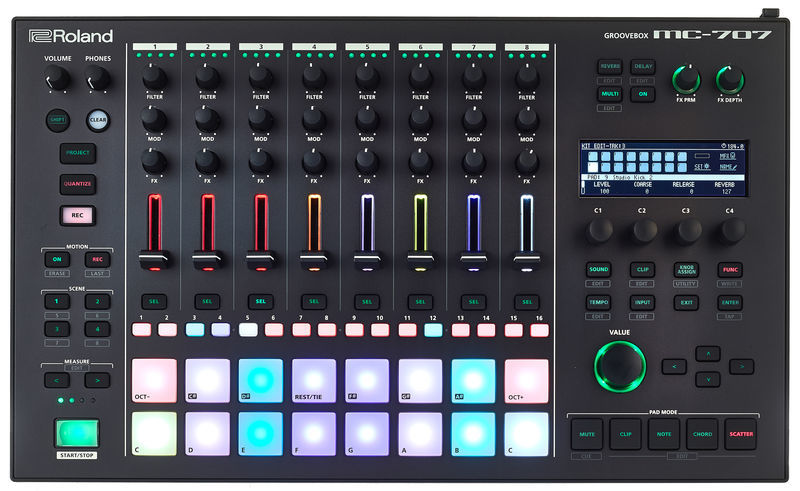
Here’s the official overview from Roland:
Specs
- ZEN-Core sound engine with up to 128 voices
- 8 Parts
- 8-Track sequencer with up to 128 steps
- 16 Clips per sequencer track
- Up to 8 loop tracks with time stretch and pitch shift
- 3000 Preset sounds and 80 drum kits
- Import user samples and loops via SD card
- Record samples via line/microphone inputs
- Available storage space for user samples: 12 minutes in mono, 6 minutes in stereo (@ 44.1kHz)
- Supported formats for user samples: WAV file (mono/stereo), 16/24 bit, 32 – 96 kHz
- Effects: EQ and multi-effects per part (90 different effect types)
- Master Effects: Compressor, EQ, Reverb, Delay and Chorus
- Record knob movements on each track
- Convenient programming via 16 backlit velocity-sensitive pads, TR step sequencer, 8 backlit faders and 3 knobs per channel
- Graphic display (256 x 80 pixels)
- Easy to switch tracks, patterns and loops with a DAW via USB connection
- Integrated USB audio / MIDI interface
- Dimensions (W x D x H): 426 x 263 x 60 mm
- Weight: 2.1 kg
- External power supply unit and SD card included
Connectors:
- Stereo mix out: 2x 6.3 mm jack
- Assignable out: 2x 6.3 mm jack
- Stereo headphone output: 6.3 mm jack
- Stereo send: 2x 6.3 mm jack
- Stereo return: 2x 6.3 mm jack
- External in: 2x 6.3 mm jack
- MIDI In/Out1/Out2
- USB-B port
Our opinion
While we like the workflow and physical interface of the MC-707, it is very expensive (around $1,000) for what it does.
If you love that console, you might think about getting the cheaper MC-101 and then supplementing with additional gear, such as Korg Volcas, to get other functions you want.
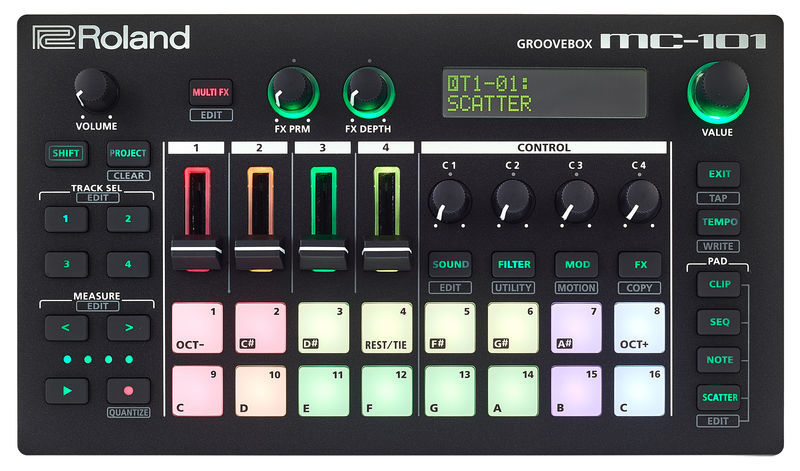
Elektron to the Rescue
Elektron has put out two great grooveboxes: the Digitakt and Digitone. These look and feel like grooveboxes.
Between the visual extremes of the large-screen Akai MPC Plus and the minimalistic Deluge, Elektron has two solutions. Each unit is priced about the same as the Akai unit.
In terms of functionality, here’s a quick breakdown of the differences between the two units:
Digitakt
- 8 internal audio tracks
- 8 dedicated MIDI tracks
- 1 × Multi-mode filter per audio track
- 1 × Overdrive effect per audio track
- 1 × Assignable LFO per track
- Delay and Reverb send FX
- Sampling capability
- 64 MB sample memory
Digitone
- 8 Voices polyphonic (multitimbral)
- Sequencer with 4 synth tracks and 4 MIDI tracks
- Multiple FM algorithms
- Each voice includes: 1 Multi-mode Filter, 1 Base / Width Filter, 1 Overdrive and 2 assignable LFOs
- 1 Arpeggiator per track
- Polyphonic sequencing
Electron Digitakt
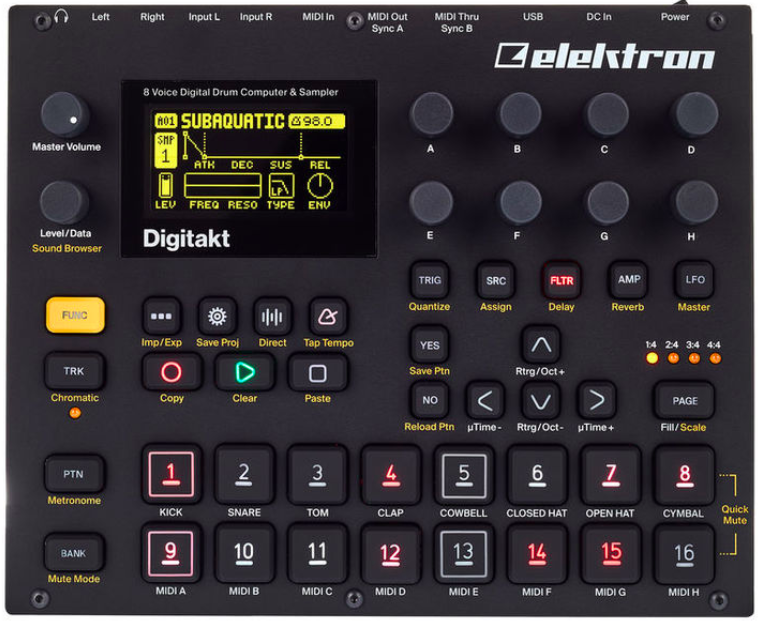
Digitakt Specs
- 8 internal audio tracks
- 8 dedicated MIDI tracks
- 1 × Multi-mode filter per audio track
- 1 × Overdrive effect per audio track
- 1 × Assignable LFO per track
- Delay and Reverb send FX
- Sampling capability
- 64 MB sample memory
- 1 GB +Drive storage
- 1 × Headphones output
- 2 × ¼” balanced main output
- 2 × ¼” input
- 1 × High Speed USB 2.0 port
- MIDI In/Out/Thru with DIN sync out
- Overbridge enabled
- Dimensions: W215×D176×H63 mm (8.5×6.9×2.5″) (including knobs and rubber feet)
- Weight: approximately 1.45 kg (3.2 lbs)
Included in the box
- Power Supply PSU-3b
- Elektron USB cable
- Quick Guide manual

For a good critical (and largely favorable) review of the Digitakt, see Ricky Tinez’s video:
(Bear in mind some of his criticisms have been addressed by Elektron’s latest firmware update.)
Digitone
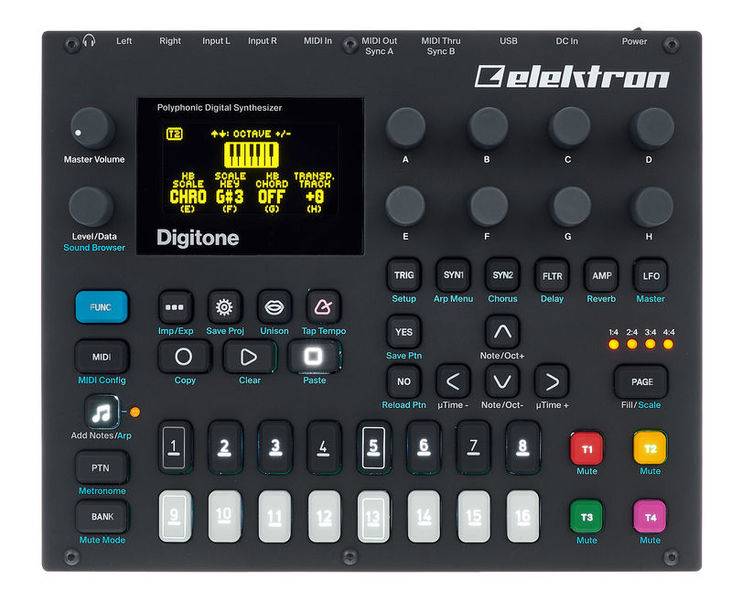
Digitone Specs
- 8 Voices polyphonic (multitimbral)
- Multiple FM algorithms
- Each voice includes: 1 Multi-mode Filter, 1 Base / Width Filter, 1 Overdrive and 2 assignable LFOs
- Sequencer with 4 synth tracks and 4 MIDI tracks
- 1 Arpeggiator per track
- Polyphonic sequencing
- Individual track length
- Parameter Locks
- Micro timing
- Trig conditions
- Sound per step change
- Send and master effects
- Panoramic Chorus Send effect
- Saturator Delay Send effect
- Supervoid Reverb Send Effect
- Overdrive master effect
- Very sharp OLED display (for optimal visibility in dark surroundings)
- Sturdy, durable and precise-looking rubber knobs and backlit buttons
- Dimensions including controls and rubber feet (W x D x H): 215 x 176 x 63 mm
- Weight: 1.45 kg

Akai Professional Force
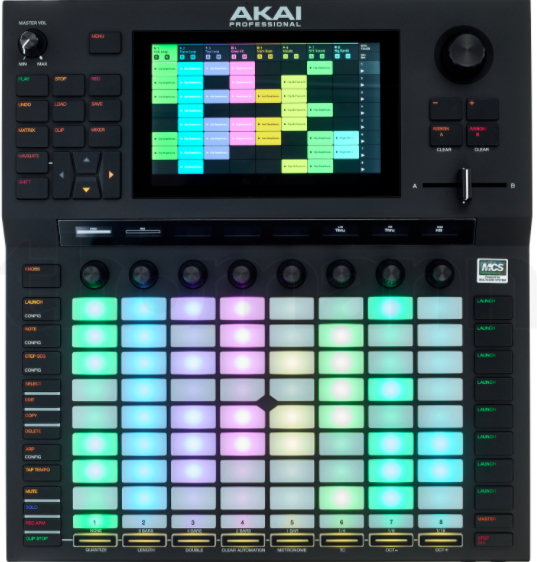
Specs
- Combines step sequencer, clip launch function, sampler and synth engines in a single device
- 7″ Touchscreen display for control
- 8×8 Clip launch matrix with RGB LEDs
- 8 Touch-sensitive controls with graphical OLED displays
- 4 Powerful and fully adjustable synth engines
- 16GB Internal Storage (over 10GB of sound content included)
- MPC Sample editing
- Remix, mash-up, DJ and produce with 6 different track types for all audio, MIDI, CV sequencing and performance needs
- 2x Audio input for microphones
- Line signals and instruments (XLR / TRS combo jack)
- 4x Audio output (6.3 mm jack)
- Headphone output (6.3 mm jack)
- MIDI In / Out / Thru (3.5 mm TRS)
- 4x CV / Gate output (3.5 mm jack)
- SD card slot
- 2x USB-A 3.0 Host Port
- 1x USB-B 3.0
- Link port
- Connection for optional 2.5″ SATA drive
- Dimensions: 350 x 389 x 72.5 mm
- Weight: 3.87 kg
[Specs from Thomann]

Elektron Octatrack
The Elektron Octatrack lies between the extremes of the Deluge and MPC One. Like Akai’s MPC it has a screen and fewer buttons than the Deluge. But like the Deluge we see a minimal screen and an overall grittier physical presence.
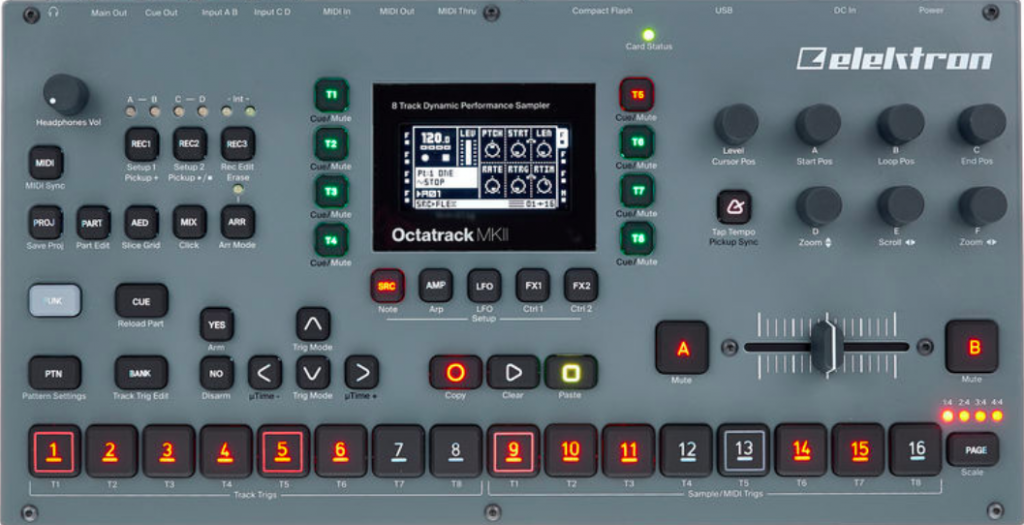
The Octatrack does have an intricate functionality which you can read about below.
The limited number of buttons and knobs makes the Octatrack look less intimidating. But it means you’re going to have to dive down if you want to access its more advanced features.
The Octatrack is much more limited in terms of tracks (only 8 = octa = Octatrack). And it is now 8 (also octa) years old.
Specs
- 8 Stereo audio tracks
- 8 Dedicated MIDI tracks
- Instant stereo sampling
- Real-time Timestretch & Pitch Shift
- 2 Insert FX per audio track
- 3 LFO per track
- Live-friendly electron sequencer
- Contactless crossfader
- 6.3 mm Headphone output
- 2x 6.3 mm Balanced main outputs
- 2x 6.3 mm Balanced cue outputs
- 4x 6.3 mm Balanced external inputs
- USB 2.0 High Speed ââport
- MIDI IN/OUT/THRU connections
- 128 X 64 OLED Screen
- Precise Hi-Res encoder
- Durable, illuminated buttons for 50 million keystrokes
- Completely compatible with Octatrack MKI projects and data
- Dimensions (W x D x H): 340 X 185 x 63 mm (including buttons and rubber feet)
- Weight: approx. 2.3 kg
[From Thomann]

